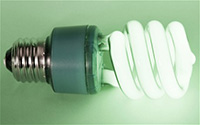
If a CFL (compact fluorescent light) bulb comes crashing down onto your floor, releasing the mercury trapped within, you don’t need to panic. Just follow these steps to safely get things cleaned up.
Fluorescent lights get their glow from the mercury trapped inside, and the compact fluorescent lights used for energy efficient household lighting are no different. So what do you do when one of these bulbs breaks, releasing that toxic mercury into your home?
First things first, you don’t need to panic. While mercury is nothing to play around with, the amount contained inside a standard CFL is only about 1 percent of the amount that you’ll find inside an old-fashioned mercury thermometer. Still, to be safe, you’ll want to be sure that you clean the mess up correctly. Here’s how to do just that, per EPA standards.
Step One: Air out the area.
As soon as that bulb breaks, you’ll want to let the room air out for about 15 minutes. Get everyone out (especially pets, who might be inclined to investigate the mess), then open the windows and shut the doors. You’ll also want to be sure and turn off your central air or heat. The last thing you want is to circulate that mercury throughout your home.
Step Two: Find a sealable container.
While you’re avoiding the area in question, go ahead and take a moment to find something capable of containing that broken bulb. A glass jar with a metal lid is ideal, but if you don’t have one handy, a plastic food container with a cover or even a sealable plastic bag will do the trick.
Step Three: Pick up the pieces.
You’ll be tempted to sweep everything up with a broom, but don’t. Anything that rifles through the broken bits of your bulb is going to risk mercury contamination. You’ll also want to be sure not to use your vacuum, as doing so will risk kicking mercury back up into the air.
The best bet is to carefully scoop up the larger bits of glass with a piece of paper or cardboard, something you can easily dispose of along with the broken bulb. Once the big pieces are up, try using a piece of duct tape to easily lift the tinier bits, along with any white powder that you see.
Step Four: Wipe the floor clean.
Once you’ve gotten the glass up off of the floor, you’ll need to wipe things down with a damp paper towel. You’ll want to go over the area fairly liberally, making sure not to leave any of that white powder from the bulb behind. Once you’re done, add that used paper towel to the container with the paper, the tape, and the broken glass. Go ahead and seal it up, then take it outside. Now would also be a good time to thoroughly wash your hands with soap and water.
Step Five: Let the room air out for another few hours.
You’ve gotten the floor clean, but there still might be trace amounts of mercury vapor left in the air. If you’re able to, leave the windows open and the air conditioning or heat off for another couple of hours.
Step Six: Dispose of the broken bulb.
Depending on your local regulations, you might not be required to take the broken bulb to a recycling center. It’s a good idea nonetheless, as you don’t want that mercury sent off to a landfill, where it might slowly leech into the ground. The waste management section of your local government’s website should have info on which facilities will take hazardous household materials off of your hands. If your local facility is open one or two days a week, it’s okay to keep the sealed container or bag for a few days. Just be sure to keep it outside in a place where no children, pets or wildlife will get into it.
If this all sounds too high maintenance for your tastes, know that you have other options. LEDs offer better energy efficiency, longer lifespans, and zero mercury inside the bulbs. If the higher price tag is a deal breaker, then consider halogens. The gas each one uses to prolong the bulb’s lifespan is totally harmless. A broken CFL might be an annoying chore to deal with, but it’s also an opportunity to upgrade to a bulb that’s a better fit for your home.
